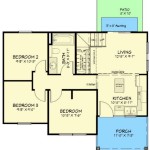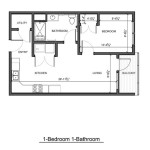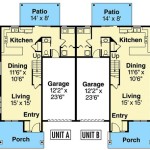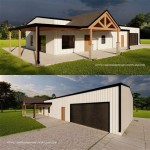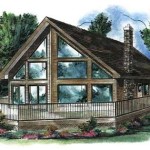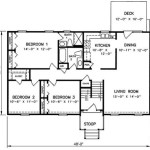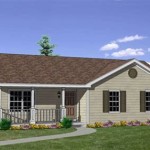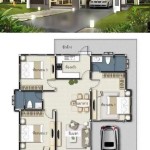The Enduring Appeal of Not Too Big House Plans
The concept of the "Not Too Big House" represents a significant shift in residential architecture, moving away from the perception that bigger is always better. This architectural philosophy emphasizes quality over quantity, prioritizing efficient space utilization, thoughtful design, and a focus on enhancing the occupants' lifestyle. The enduring appeal of not too big house plans stems from a variety of factors, including economic considerations, environmental awareness, and a growing desire for a simpler, more manageable lifestyle.
These house plans cater to individuals and families who recognize the benefits of a smaller footprint. A smaller home often translates to lower construction costs, reduced property taxes, and significantly less maintenance. Furthermore, not too big houses are generally more energy-efficient, leading to lower utility bills and a smaller carbon footprint. The design focuses on creating comfortable and functional living spaces without unnecessary square footage, promoting a more sustainable and eco-conscious way of life.
The appeal also lies in the inherent design challenges and opportunities. Architects and designers working on not too big houses must be particularly creative and resourceful in maximizing every inch of space. This often leads to innovative solutions such as multi-functional rooms, built-in storage, and strategically placed windows to enhance natural light and create a sense of spaciousness. The result is a home that feels larger than its actual size, offering a comfortable and welcoming environment for its occupants.
Financial Advantages and Practical Considerations
One of the most compelling reasons for choosing a not too big house plan is the immediate and long-term financial advantages. The initial construction cost is generally lower compared to larger homes, owing to reduced material requirements, fewer labor hours, and simpler infrastructure. This allows homebuyers to allocate their resources to higher-quality finishes, sustainable building materials, or other features that enhance the living experience.
Property taxes are often assessed based on the square footage of the home, meaning that a smaller house will typically result in lower annual tax bills. This ongoing savings can significantly reduce the overall cost of homeownership. Similarly, homeowners insurance premiums are often tied to the replacement cost of the property, which is usually lower for smaller homes.
Beyond the direct financial benefits, a smaller home also translates to lower utility bills. Reduced heating and cooling needs, less water consumption, and lower electricity usage contribute to significant savings over the lifespan of the house. These savings not only benefit the homeowner's budget but also contribute to environmental sustainability by reducing the overall demand for resources.
Practicality is another key aspect of the financial advantage. Smaller homes require less time and effort to clean and maintain. This can be particularly appealing to busy professionals, empty nesters, or anyone who prefers to spend their time on activities other than household chores. The reduced maintenance burden translates to more free time and a less stressful living environment.
Emphasis on Design and Functionality
Not too big house plans prioritize intelligent design and efficient space utilization. The focus is on creating functional and comfortable living spaces without unnecessary square footage. This often involves innovative solutions such as open floor plans, multi-functional rooms, and strategically placed storage areas. The design aims to maximize every inch of space, creating a home that feels larger and more comfortable than its actual size.
Open floor plans are a common feature in not too big houses, as they create a sense of spaciousness and allow for better flow between living areas. By eliminating unnecessary walls and partitions, open floor plans enhance natural light and create a more inviting atmosphere. This type of layout is particularly well-suited for modern lifestyles, where socializing and entertaining are often centered around the kitchen and living area.
Multi-functional rooms are another key element of not too big house design. A guest bedroom, for example, can also serve as a home office or hobby room. A dining area can be transformed into a workspace when not in use for meals. This type of flexible design allows homeowners to adapt their living spaces to their changing needs and preferences.
Built-in storage solutions are crucial for maximizing space in smaller homes. This can include built-in bookshelves, closets, and cabinetry. These storage areas not only provide ample space for belongings but also help to keep the home organized and clutter-free. Strategic placement of storage areas can also enhance the overall aesthetic of the home, creating a more visually appealing and functional living environment.
The use of natural light is also carefully considered in not too big house design. Large windows and skylights are strategically placed to maximize natural light throughout the day. This not only brightens the interior spaces but also reduces the need for artificial lighting, contributing to energy savings. Natural light can also enhance the overall mood and well-being of the occupants.
Environmental Considerations and Sustainable Living
The emphasis on sustainability is a significant driver of the popularity of not too big house plans. Smaller homes generally have a lower environmental impact than larger homes, due to reduced material consumption, lower energy consumption, and less land usage. This aligns with the growing awareness of environmental issues and the desire to live a more eco-conscious lifestyle.
Reduced material consumption is a direct result of building a smaller home. Less lumber, concrete, and other building materials are required, which translates to lower embodied energy and reduced waste. Choosing sustainable building materials, such as recycled content products and locally sourced materials, can further reduce the environmental footprint of the home.
Lower energy consumption is another key benefit of not too big houses. Smaller homes require less energy for heating, cooling, and lighting. This can be achieved through efficient insulation, high-performance windows, and energy-efficient appliances. Incorporating renewable energy sources, such as solar panels, can further reduce the home's reliance on fossil fuels.
Less land usage is an important consideration in areas with limited land availability. Smaller homes require smaller lots, which helps to preserve green spaces and reduce urban sprawl. This can also lead to more compact and walkable communities, which further reduces the environmental impact of transportation.
The principles of sustainable design are often integrated into not too big house plans. This can include features such as rainwater harvesting systems, greywater recycling systems, and passive solar design. These features help to conserve water, reduce waste, and minimize the home's environmental impact.
In essence, not too big house plans offer a practical and environmentally responsible approach to homeownership. They allow individuals and families to live comfortably and sustainably without unnecessary financial burdens or environmental impacts. The focus on intelligent design, efficient space utilization, and sustainable building practices makes them an increasingly attractive option for those seeking a simpler and more fulfilling lifestyle.
The flexibility inherent in these designs also allows for future expansion if needed. A well-designed not too big house can be easily adapted to accommodate a growing family or changing lifestyle needs. Additions can be added to the side or rear of the house, or the interior spaces can be reconfigured to create more living space. This adaptability ensures that the home remains functional and relevant over time.

Home By Design Showhouse Sarah Susanka

Not So Big House Sudaiva Studio Archdaily

Pin Page

Orlando Showhouse Sarah Susanka

Susanka Com

Not So Big Bungalow By Sarah Susanka Houseplans Blog Com

Susanka Com

Not So Big Plans Minnesota Monthly

Not So Big House Sudaiva Studio Archdaily

Not So Big House Plans Archives Sarah Susanka

